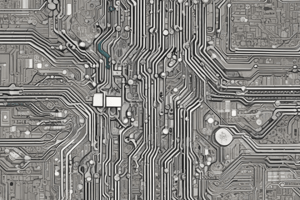Podcast
Questions and Answers
What is the first step in applying the Mesh Current Method?
What is the first step in applying the Mesh Current Method?
- Identify distinct meshes in the circuit (correct)
- Solve the system of equations
- Assign mesh currents for each loop
- Apply Kirchhoff's Voltage Law
How is voltage across a resistor expressed in the context of the Mesh Current Method?
How is voltage across a resistor expressed in the context of the Mesh Current Method?
- V = IR (correct)
- V = R/I
- V = I^2R
- V = I + R
Which of the following statements about the Mesh Current Method is true?
Which of the following statements about the Mesh Current Method is true?
- It reduces the number of equations compared to node-voltage analysis. (correct)
- It does not require the use of Kirchhoff's Voltage Law.
- It can be used for non-planar circuits.
- It eliminates the need to consider voltage sources.
What role does a current source play in a mesh when using the Mesh Current Method?
What role does a current source play in a mesh when using the Mesh Current Method?
What is a significant limitation of the Mesh Current Method?
What is a significant limitation of the Mesh Current Method?
Flashcards are hidden until you start studying
Study Notes
Mesh Analysis - Mesh Current Method
-
Definition: The Mesh Current Method is a systematic technique used to analyze planar circuits. It relies on Kirchhoff's Voltage Law (KVL) to write equations for mesh currents in loops of a circuit.
-
Key Concepts:
- Mesh: A loop that does not contain any other loops within it.
- Mesh Current: A hypothetical current that flows around a mesh in the direction defined (usually clockwise).
-
Steps in the Mesh Current Method:
-
Identify Meshes:
- Determine distinct meshes in the circuit.
-
Assign Mesh Currents:
- Assign a mesh current (I1, I2, etc.) for each mesh in the circuit.
-
Apply KVL:
- For each mesh, apply KVL: the sum of voltage drops around the mesh must equal zero.
- Write equations using the assigned mesh currents, accounting for voltage sources and resistors:
- Voltage across a resistor: V = IR
- Voltage from a source: +/- V (polarity matters)
-
Solve the System of Equations:
- Use algebraic methods to solve the simultaneous equations obtained from KVL for each mesh current.
-
-
Considerations:
- If a current source is present in a mesh, it directly defines the mesh current.
- For dependent sources, express the dependence in terms of the mesh currents.
- If required, convert mesh currents to actual branch currents by adding or subtracting mesh currents.
-
Advantages:
- Systematic approach allows for easy handling of complex circuits.
- Reduces the number of equations compared to node-voltage analysis in circuits with many nodes.
-
Example Problems:
- Analyzing circuits with resistors and independent voltage/current sources.
- Including dependent sources in mesh equations.
-
Limitations:
- Limited to planar circuits (those that can be drawn on a plane without crossings).
- Requires familiarity with KVL and handling of simultaneous equations.
Mesh Analysis: The Mesh Current Method
- Method for analyzing planar circuits using Kirchhoff's Voltage Law (KVL).
- Relies on hypothetical mesh currents flowing around loops.
Defining Meshes and Currents
- Mesh: A loop not containing other loops.
- Mesh current: Hypothetical current assigned to each mesh, usually clockwise.
Applying the Mesh Current Method
- Step 1: Identify all distinct meshes in the circuit.
- Step 2: Assign a unique mesh current (e.g., I₁, I₂, etc.) to each mesh.
- Step 3: Apply KVL to each mesh: The sum of voltage drops around each mesh equals zero. Account for resistor voltage drops (V = IR) and voltage source polarities.
- Step 4: Solve the resulting system of simultaneous equations to find the mesh currents.
Special Considerations
- Current sources within a mesh directly define that mesh's current.
- Dependent sources require expressing their dependence in terms of mesh currents.
- Branch currents are calculated by summing or subtracting relevant mesh currents.
Advantages and Limitations
- Advantages: Systematic; fewer equations than node-voltage analysis for many-node circuits.
- Limitations: Only applicable to planar circuits; requires KVL understanding and solving simultaneous equations.
Applications and Examples
- Analyzing circuits with resistors and independent voltage/current sources.
- Incorporating dependent sources into mesh equations.
Studying That Suits You
Use AI to generate personalized quizzes and flashcards to suit your learning preferences.




